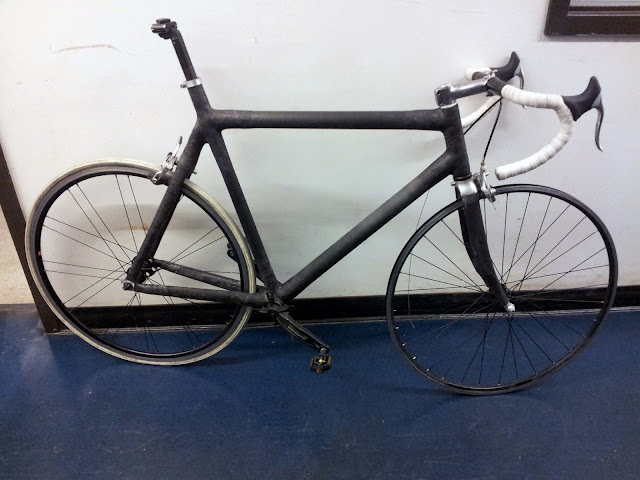I also made a simple seatpost clamp out of aluminum:
And here is the bike, in its current state:
The only remaining features I need to add to the frame are cable stops for the back brake.
From some thorough testing of the electric tricycle, I found a pretty major design flaw. When turning sharply at speed, it was possible to over-lean, causing the foot pegs on the front wheel to scrape the ground. This would torque the front wheel sideways, sending the rider over the handlebars. I honestly just did not expect to ever lean so far in turns, so I built in no sort of lean-limiting features.
The easiest and least intrusive way to limit leaning was to add stops just under the seat. I bent some thick steel rod, and welded it under the seat frame. I added nylon caps to the ends, so the steel will not gouge into the aluminum.
From some testing in a wet parking garage, the stops seem to be strong enough. When cornering, the water caused the back wheels to slide out. Normally, this would have sent the foot pegs into the concrete. Once I get used to the stops, the should let me slide around corners without having to put my feet down.
Also, CPW happened. A host of prefrosh swarmed MITERS, and built things like ducted fan powered RC vehicles, Jacob's ladders, and more. A significant portion of them rode the trike up and down the halls of N52. I'm happy to say that it was a big hit, and neither it nor any prefrosh sustained any damage.
Back on Putz, we did some science. It started with left over liquid nitrogen from CryoFAC , and devolved into burning things with a 12 kV neon sign transformer. We found that some interesting things happen when you put twelve thousand volts through damp wood. The electricity slowly burns through the least resistance path in the wood, creating a sort of high-carbon wire that glows bright orange. This effect could be controlled by laying down graphite on the surface of the wood with a pencil. The graphite trace directs the current, which then burns the wood along the trace. Here's what "EC" burned into the wood looks like:











